Podcast: Play in new window | Download
Subscribe: RSS
November marks the final month of the college football regular season for most teams. You can be sure that many schools are thinking about whether or not they should retain their current head football coach after this season, too.
Economics will provide an objective factor in arriving at the decision. If your current head coach is underperforming on the field for multiple years, there is a very good chance that home attendance has been falling a bit, too. Losing thousands of season ticket holders is always a bad sign for the current coaching regime.
However, there are emotional aspects related to this decision, too. They will drive the timing on the decision on whether to keep or dismiss a major college football coach.
The higher the coach’s annual pay, the more intensely the team’s fan base expects to see success on the football field.

In recent years, most coaches (and their agents) have negotiated long-term contracts which contain up to 100% guaranteed pay for the entire term of the deal – even if the coach is dismissed years before the contract expires.
The payoff of these contracts usually falls on the desire to make a change pushed by the athletic department’s largest financial backers. They will huddle with the school’s administration and often ante-up 100% of the money required to pay the costs associated with the exiting coach’s contract and any costs associated of bring a new coach onboard.
It’s not just the payoff of the current contract, either. This exercise gets a lot more expensive as the potential new coach (a success at his current school) works under a contract with his current employer. A contract buyout must be paid to the former school to buy the coach out of his existing employment agreement.
This amounts to an incredible amount of money in many cases.

The school’s athletic boosters have become, effectively, the financial “owners” of the school’s athletics program. Without their assistance, the pay levels for major college football coaches in most state universities would be a fraction of today’s going rates.
These boosters must be able to bankroll paying-off their fired coach’s contract and then fork over more millions to buy-out the targeted new coach’s existing employment agreement. If the boosters can cover the costs, the university’s administration and the athletics department will generally go along with making the changes.
High finance, indeed!
The “right time” to dismiss the head coach often comes after an embarrassing and/or unexpected loss, at the end of more than one disappointing seasons, or if the school has a number of embarrassing off-the-field issues which are affecting wins and losses.
The first big name casualty of the 2023 season just happened on Sunday.

Texas A&M head coach Jimbo Fisher was terminated after almost six seasons in Aggieland. After coming from a successful stint at Florida State, Fisher moved to College Station for the start of the 2018 football season. In the past few years, the Aggies regularly boasted of having top 5-level recruiting classes. However, the football team posted four or more losses in all but the COVID-shortened season in 2020.
Though the Aggies are now 6-4 and likely to finish above .500, the Texas A&M athletics director said that the school hired Coach Fisher to compete for national championships – not middle-of-the-pack finishes in the SEC.
Despite being paid more than $9 million per year, Jimbo Fisher’s bosses believe that he failed his mission to return Texas A&M to the top of the SEC and play for championships.
So, he’s out.

However, Texas A&M’s current contract with Jimbo Fisher called for a fully guaranteed deal worth a total of $95 million over a ten year period. He still has an estimated $76 million remaining on his contract with the Aggies.
According to one source, the contract called for Coach Fisher to receive $19.2 million within 60 days of his dismissal. After that, he will receive a nifty $7.2 annually through 2031.
Texas A&M’s athletics director Ross Bjork said that the university is not on the hook for this extraordinary cash outlay to get rid of the football coach. He said, “Let me be very clear… Texas A&M athletics and the 12th Man Foundation will be the sole sources of the necessary funds covering these transition costs.”

Using my best Jed Clampett imitation, “Whale Doggies! $76 million is mighty charitable for ol’ Jimbo Fisher. How ‘bout those Texas Aggies!”
But wait! There’s more!
As I write this story today, the head coach of Texas A&M’s most recent opponent on Saturday night was just fired, too.

Mississippi State head football coach Zach Arnett (whose 4-6 Bulldogs lost 52-10 at Texas A&M this weekend) was terminated after just ten games as the “top dog” in Starkville. The 37-year old Arnett was the defensive coordinator under long-time head coach Mike Leach, who died last December at age 61. This was Zach Arnett’s first college head coaching job.
For the record, Mississippi State was paying their young head coach about $3 million annually. He was the lowest paid football coach in the SEC this season. A source indicated that Zach Arnett will be due about $4 million under his contract agreement unless he takes a job elsewhere (quite likely at his age).
Is Woo Pig Sooey next?

Arkansas Razorbacks head football coach Sam Pittman’s team is just 3-7 this season. Now in his fourth season in Fayetteville, the affable 61-year old first time head coach (and his $6.3 million annual pay) could be the next SEC coach to be sent home soon.
Under Sam Pittman, the Razorbacks went 3-7 in COVID-2020, and then exploded to 9-4 in 2021. Unfortunately, Arkansas slipped to 7-5 in 2022 and is currently at 3-7. The Hogs were totally embarrassed – at home – by a heretofore pedestrian 6-4 Auburn Tigers team 48-10 on Saturday. Arky will be at home for the final two weeks of the regular season. This week, they face 4-6 Florida International and then end the season against 8-2 Missouri.
In the SEC, it’s considered “Win soon…or else!” (except at Vanderbilt after most seasons).
Has anyone seen Jim Harbaugh?

While we’re discussing coaches, let’s dive into the odd case of Jim Harbaugh and the Michigan Wolverines.
On Saturday, Michigan’s $8.25 million head football coach was given the day off by the Big Ten Conference for the Wolverines’ road game at Penn State. They suspended Jim Harbaugh for Michigan’s three final regular season games – at Penn State, at Maryland (this week), and the season finale (at home) versus rival Ohio State on Saturday, November 25 following Thanksgiving.
This suspension involves a rather unique sign-stealing scandal which may have involved the knowledge of one or more Michigan football coaches. The Wolverines have appealed the suspension with Big Ten Conference officials.

Don’t forget that Coach Jim Harbaugh had already been suspended for Michigan’s first three games of the year, too! The school’s punishment was related to a recruiting issue.
Michigan is now 10-0 this season. They are 6-0 with Jim Harbaugh on the sidelines and 4-0 without him.
It makes you wonder if so many of these highly paid head coaches are really worth the money.
Spoiler alert! That will be the subject of Part 2 of this story- coming tomorrow!

If you might be wondering how much today’s college football head coaches earn, I was able to find a source which published the annual pay for 120 of the 133 FBS head football coaches in 2023. Several of the private universities do not publish the details of coaching contracts.
The national average salary for the 120 reporting college coaches was just under $3.7 million. To no surprise, the top pay of $11.4 million went to Alabama’s Nick Saban.

The lowest paid head football coach last year was UL-Monroe’s Tommy Bowden at $435,000.
The incredible new TV contracts are doling out a lot of cash to the largest FBS football conferences. That is fueling the rising pay scale.
Below is the average pay (from lowest to highest) for head football coaches by conference:
Mid-American Conference $713,822 per year
Sunbelt Conference $800,136
Conference USA $820,288
Mountain West $1,483,655
American Athletic Conference $1,724,910
Big 12 $4,674,708
Pac-12 $5,243,561
ACC $5,396,368
Big Ten $6,744,323
SEC $7,611,070
Below is a complete list – the 120 coaches, annual pay and their rank within the entire group – sorted alphabetically by Conference:
![]()
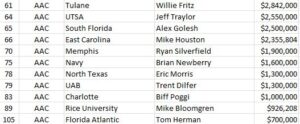
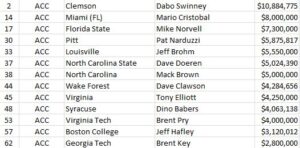
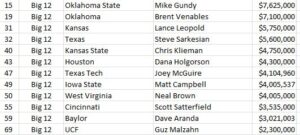


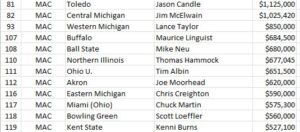

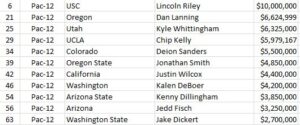
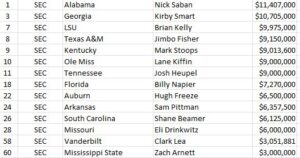

Next time: Are College Football Coaches Worth the Money – Part 2

